After the Conrail takeover, #23 is sitting at the Bethlehem facilities backed up to a Lehigh Valley Alco.

After the Conrail takeover, #23 is sitting at the Bethlehem facilities backed up to a Lehigh Valley Alco.

L&HR #21, now Conrail #2072 and wearing a Conrail patch lettering sits next to a Delaware & Hudson GP39-2, still wearing Reading colors but with a D&H patch job.

#21 became the only Alco C420 to wear the Conrail big blue paint scheme. Most of the others were given hasty patch job lettering and sold off fairly early on.




NickD said:L&HR #21, now Conrail #2072 and wearing a Conrail patch lettering sits next to a Delaware & Hudson GP39-2, still wearing Reading colors but with a D&H patch job.
So, its worth noting that there is actually six railroads represented in this photo. The GP39-2 is wearing Reading colors (1) and D&H heralds (2) and the C420 is wearing L&HR colors (3) and Conrail lettering (4). The fifth is that they are at the Bethlehem engine facilities, which were constructed and owned by the Lehigh Valley. And the sixth is that those Reading GP39-2s were actually owned by Chessie Systems, who leased them to Reading. Why? Chessie Systems had long looked at acquiring the financially-ailing Reading and was trying to prop the Reading up so that they didn't inherit a line that was in total disrepair. So when the Reading needed new motive power, Chessie Systems purchased 20 2300hp GP39-2s and leased them to the Reading to give their motive power fleet a shot in the arm. These would be the last new diesels on Reading property, arriving in 1974.

Now here is where it gets interesting. Rather than let Chessie Systems acquire Reading, the government decided to roll Reading up into Conrail to save the flagging northeast railroad industry. Meanwhile, Delaware & Hudson, which was also in dire straits, was lobbying to be included in Conrail as well. But the ICC was worried that if they left Conrail without any competitors in the northeast, it would run afoul of monopoly laws. So the D&H was left out and instead almost doubled in length, when the ICC gave them duplicate trackage that Conrail had no need for as well as trackage rights over Conrail, the hope being that giving the D&H access to new customers would turn its finances around and make it able to compete with Conrail. D&H would require additional motive power, and everyone thought that Conrail was going to stick the D&H with the oldest, most worn-out, oddball junk, but instead, D&H was given free reign to raid the cookie jar and they took the 20 Reading GP39-2s (to join 20 more that D&H already owned), Lehigh Valley's 12 C420s and Lehigh Valley's 12 GP38-2, all some of the shiniest, newest equipment in Conrail's pool. Delaware & Hudson now began paying Chessie Systems to lease the GP39-2s, renumbering them (#3403 becoming #7403) first painting them in an unusual dark blue and yellow scheme, and then the later usual light blue, gray and yellow.


When the Delaware & Hudson was rolled up into Guilford Systems in 1984, some of their GP39-2s were repainted in the dark grey and orange with the Guilford logo and D&H lettering. I can't find any photos of #7403 wearing that scheme though. In 1991, Canadian Pacific purchased the D&H from Guilford. At this point, Canadian Pacific decided not to continue the lease on the 20 ex-Reading GP39-2s and ownership reverted to Chessie Systems, who had since merged with Seaboard Systems/Family Lines to become CSX. Now for the first time in 27 years, CSX actually got usage of engines that they had purchased in '74.


#4034/#7034, now renumbered to #4311 and with CSX lettering but wearing the D&H paint scheme still. Also worth noting that the GP40 it is hooked up to is wearing old Richmond, Fredericksburg & Potomac paint. As late as 2019, CSX #4311 was still on the job, 45 years after purchase.
In reply to NickD :
The lifespan of locomotives is incredible. Sure, there are some old ocean-going ships still in service too, but when was the last time you saw a 45-year old semi still in regular freight service?
In reply to Pete Gossett (Forum Supporter) :
Yeah. And while that exact Alco C420 its parked next to at Bethlehem is no longer extant (it was hand-painted to Conrail colors and then scrapped less than a year later) some of the Lehigh & Hudson River C420s are still in use on the Arkansas & Missouri to this day. And they were ten years older than the GP39-2.
A good example of the L&HR C420s long life is the #29.
#29 was built for the L&HR in 1965 as the very last of Lehigh & Hudson River's 8 C420s. It served them for 11 years until L&HR was incorporated into Conrail.

When Conrail took ownership of it, they renumbered it to #2077. It was never repainted into CR blue, but instead just got the Conrail patch lettering. Conrail was pretty quick in unloading their Alco's, as the newest were 7 years old at the time, and Alco was no longer in business, making parts supply a bit tricky. Its shown here at Bethlehem with an ex-Lehigh Valley RS11 and an ancient EMD switcher.

In 1981, Conrail had parked the #29/#2077, which must have made it among the last of the C420s still on the property. They sold it to Delaware & Hudson, who was still using their ex-Lehigh Valley C420s, to part out. D&H instead found it to be in good mechanical condition and they put it into operation as #401. Again, it wasn't painted in D&H colors, remaining in very faded L&HR colors with D&H lettering now applied over the Conrail lettering which was over the top of the L&HR lettering. She looked pretty ragged.

ALCO: All Liquids Come Out?

In 1985, Guilford Lines, the caretaker of D&H, ran it through their paint shops and applied the Guilford Lines orange and dark gray and it was renumbered to #420.
%20Bing.,NY%209'23'85.jpg)
In the late 1980s, Guilford got rid of their Alcos, and #29/#2077/#401/#420, went to the midwest where it was repainted into dark red, blue and gold and became Arkansas & Missouri #58. A&M is a well-known Alco sanctuary, and the #58 is still operational there today, along with L&HR #22, #23, #24 and #25.

Its rare to say, but I think the D&H looked better in the diesel era than it ever did the steam era. That's unusual, because I think a lot of railroads lost their visual appeal when they dieselized, or stayed about the same (New York Central and New Haven are good examples of that). But D&H steam engines were always so ugly and bizarre.
Take their 4-6-0s and 2-8-0s with their fat boilers, wide Wooten fireboxes and unique external ashpans that nearly obscure the rear drive wheels, plus headlights perched near the top of the smokebox but not on top of it.
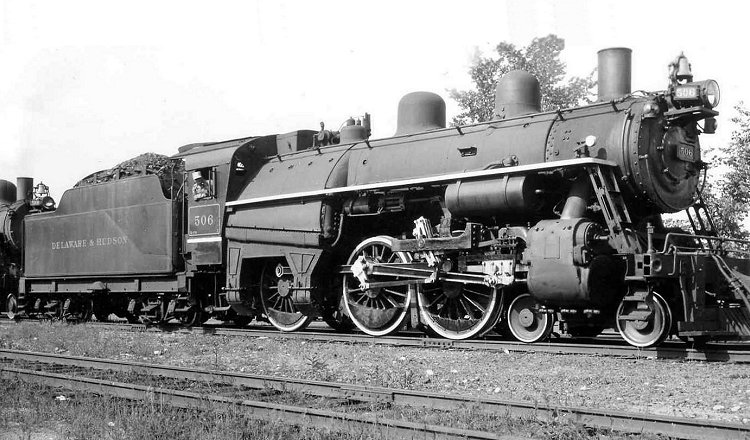

Or their 4-6-2 Pacifics, with their headlamp recessed into the smokebox door, "elephant ear" smoke deflectors, flared smoke stack, shrouded front deck and sizable gap between the tops of the drivers and the running boards
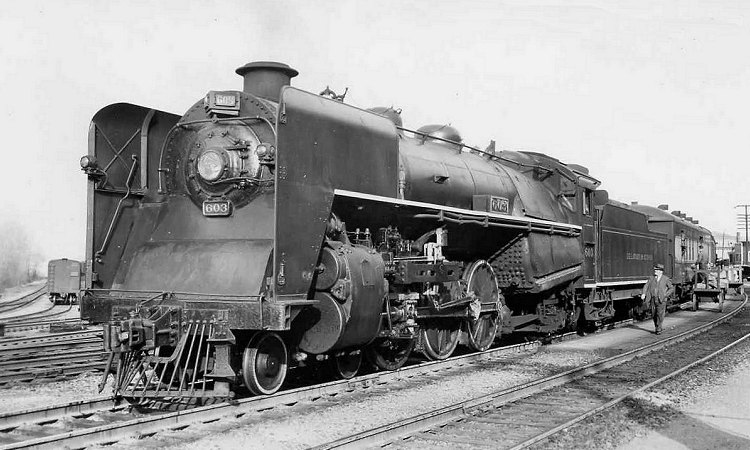
Their 4-8-4s were similarly odd-looking, again with the recessed headlamp and elephant ears

And their big 4-6-6-4 Challengers, with a shrouded headlight mounted in the center of the smokebox (unusual for an articulated) just looked dainty instead of huge and powerful (which they were)
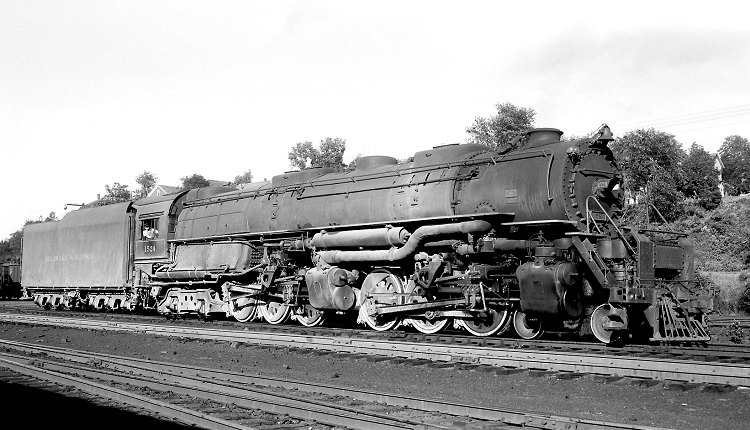
But then look at their diesel operations: Strictly Alco until 1967, they used hordes of RS2s and RS3s, supplemented with bigger RS11s and rare RS32s, later joined by C420s, C424s, hulking C628s and C630s. EMD power didn't show up until SD45s were acquired from Erei-Lackawanna, along with GP39-2s and GP38-2s. GEs arrived in the form of stout U30s and U33s. And all of them were painted in the gorgeous light gray, Champlain Blue and gold with lightning stripes and the D&H herald.





While Alcos got long in the tooth and were retired elsewhere, D&H kept theirs on the job long into the '80s, re-engining their RS3s and chopping their RS11 noses. And then in '74, D&H went out and bought the last 4 Alco PAs (D&H's first cab unit purchase) and the last 2 Baldwin RF-16s, overhauled them, and put them into general revenue service, to the delight of railfans.


Yes, D&H in the diesel era was much more stylish than the steam era.
During D&H's sesquicentennial in 1973, the D&H really wanted to celebrate with steam-powered excursions. The problem: The D&H had cut up every steam locomotive in their inventory in '52 when they had dieselized. Enter Reading T-1 4-8-4 #2102

One of the 4 big "T-Hogs" that the Reading had held onto after dieselization and used in the Iron Horse Rambles, the engine had been sold in '67, after the Reading discontinued the Rambles, to Steam Tours Inc, in Akron, Ohio. The Reading T-1s, under their various owners, kind of became the steam stars of the '70s, running just about everywhere in a number of different guises. So, the #2102 received "elephant ear" smoke deflectors, a new smokebox door with a recessed headlamp, white paint detailing on the running boards, and was relettered to "Delaware & Hudson #302".


It was honestly a pretty convincing facsimile. The pilot deck covering was the only really obvious deviation.

The #302 then stormed up and down D&H tracks at speed hauling passengers for 2 days. #2102 would actually wear the D&H disguise for a while before reverting back to her original appearance.
In 1973, the D&H was also involved in another steam excursion, but this one never came to be for very weird circumstances. It's a frequently mistold story as well. It involves Nickel Plate #759 and the reported freeze damage.
#759 was one of the New York, Chicago & St. Louis' famed Lima-built 2-8-4 Berkshires. It was built in '44 and was operated by the Nickel Plate Road up until the end of steam operations in '58.

After retirement from regular operations, the NKP ran a bunch of their Berkshires through the shop and completely overhauled them and then set them aside in storage. They remained convinced there would be a major traffic boom and they would need to fire the old steam engines up to help with the excess traffic. #759 was actually the last steam engine to be shopped by the NKP's Conneaut, Ohio shops.

By 1962, the NKP realized that they were never going to use these engines again, and so they began selling off, donating and scrapping these zero-mileage locomotives. The #759 was purchased by that guy who's name repeatedly comes up, Nelson Blount, and moved to Bellows Falls, Vermont, to be displayed at Steamtown USA's ex-Rutland facilities.

Steamtown USA really had no interest in operating the #759, as it was a bit large for what they were doing and they already had a handful of CP G5 Pacifics running around, but as a member of what is considered one of the finest steam engines built, it was a nice addition to the collection. Then in 1968, New York commodities broker Ross Rowland began planning for the 150th anniversary of the driving of the Golden Spike at Promontory Point, completing the first transcontinental railroad. The idea was to haul an excursion with displays for the past, present and future of railroading from New York City to Salt Lake City. And Rowland wanted it steam powered. So, he leased the #759 from Steamtown, sent it back to the now Norfolk & Western-owned Conneaut shops and had it restored to operation (it did not need much). It made a few test runs at Steamtown at the end of '68 and then in '69 she was off across the country. Aside from some poor-quality coal and trying to coordinate coal and water stops (remember, all those coaling and watering facilities that dotted the nation were no longer operational) it was a smashing success and would pave the way for the American Freedom Train, also headed by Rowland, in '76.


After completing the Golden Spike Limited, the #759 went back to Steamtown USA and saw limited usage over the years. It was still a bit on the big and heavy side for them, but it ventured off the property occasionally, either leased out by Rowland's company or operated by Steamtown.

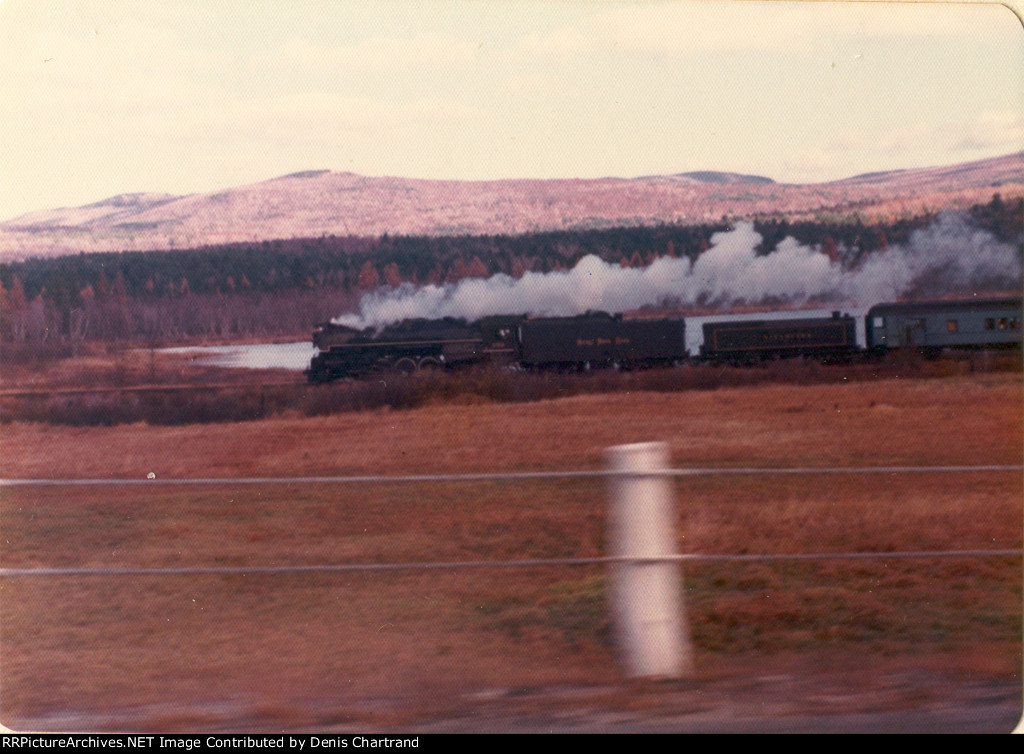
In late 1973, Steamtown USA entered talks with the D&H to send the #759 down with CP Pacifics #1246 and #1278 (the fated Gettysburg engine) to lead a multi-day excursion that would go from Albany, NY to Scranton, PA over D&H rails in earky '74. The #759 would be the main road engine, with #1246 and #1278 acting as helpers on the big grades. The D&H put one of their employees, Dick Williams, in charge of positioning fuel and water for the excursion and coordinating efforts with Steamtown to not disrupt traffic. Knowing that Steamtown had no heated facilities, D&H kindly offered to store the Berkshire indoors at their Rouses Point facility and the Pacifics at Plattsburgh for the winter so that they didn't need to be winterized for the winter.
The #759 was steamed down by itself in November and tickets went on sale, with news spreading of the big excursion. This is where things got weird. Railfans began writing and calling Steamtown and asking for the dates and times and locations of the excursion so that they could photograph it as it went by and pace and chase the train. Steamtown director Bob Barbera gets pissed off at the idea of fans wanting to chase and photograph the locomotives without paying for a ticket, and makes the announcement that the engines will be "shrouded" with sheets will operating, except for when they would be removed at an undisclosed location for paying ticketholders to perform a couple flybys for paying ticketholders. Railfans get pissed off now and start complaining to the D&H. The D&H calls Barbera and says they want no part of covered-up steam locomotives running around. Babera tells them they are his engines and he can do that if he wants. The D&H fires back that they are their rails and those engines don't roll without their say-so. And so, when Barbera refuses to back down, D&H pulls their support and the excursion is cancelled.
The Pacifics had never been sent down to Plattsburgh, as Steamtown had decided to keep them on site and operate them through the winter. But #759 was already at the Rouses Point facilities. What hadn't been conveyed by the D&H was that when they pulled the plug on the excursion, they also rescinded the offer to store #759 indoors. So, without draining the water from the engine or winterizing it, they shoved the engine out in the yard and let it sit all winter. Steamtown sends their people down to retrieve the engine in the spring and finds that it had suffered some freeze damage to components in the feedwater heater and some of the staybolts.

Here is where this story always gets told wrong: According to most people, including park employees, the #759 suffered severe damage and was not repaired, was not ever operated and is too expensive to return to operation, because of how extensive the freeze damage is. This is not true.
Steamtown retrieved the #759 and subsequently sued the D&H for damages and won. The D&H actually, before the lawsuit was even settled, hired someone to go to Bellows Falls and oversee repairing the minor freeze damage and the #759 was fired up and shuffled around the Steamtown yard a few times to make sure it was fixed. By the time the lawsuit wrapped up, the FRA flue certifications had run out of time and Steamtown decided not to put flues in it as it was just too big for them, although they said that if anyone expressed interest in leasing it or operating it, they would be willing to work with them.
This is the truth of it: there is no major, irreparable freeze damage. In fact, even the minor freeze damage was fixed in '74 and the engine operated once. In fact, #759 is really in extraordinary mechanical condition. It had a major overhaul in '58, was not operational until '68, and then was used only sparingly between '68 and '73. Ross Rowland would look at #759 to haul the American Freedom Train in 1976 (along with sister #763) but the board of directors on the AFT were instead talked into restoring SP #4449 by Doyle McCormack. This was a bad move, as #4449 wouldn't fit a lot of eastern clearances and for the eastern leg Rowland pulled Reading #2101 from a junkyard and completely rebuilt it in 30 days(!).
In 1977/1978, a potential operator also approached Steamtown about operating the #759 and they attempted a hydrostatic test to see if the tubes were still good (the plan was to get the FRA to give them an extension on the flues due to limited use) and during the hydrostatic test a tube blew. The interested party wanted to retube the boiler and Steamtown pulled the flues out and sent it out to have the new flues installed by Dillon Boiler. Dillon Boiler asked for a down payment for the new tubes before ordering them, the operator flaked out, and the engine was sent back to Steamtown. So really, it would be less work to get the boiler operating because you wouldn't have to remove the old flues, just install new ones (and someone has the blueprints to make those thanks to #765).
Rowland would also look at the #759 again in the 2000s for his Greenbrier Presidential Express, to operate with C&O #614, but that operation never got off the ground.

These days, #759 sits around the Scranton site of Steamtown National Historic Site, unlikely to operate anytime soon. Again, nothing to do with "irreparable freeze damage" but just due to her sheer size. She fits in the roundhouse with only a foot or so to spare, barely squeaks onto the turntable, and would have trouble negotiating the ready track out of the turntable. Its noted to be incredibly hard to get a photo of #759 due to it usually being squeezed in the roundhouse, although it does get pulled out every once in a while for photo shoots. It did have asbestos abatement and paint in 2010 and was again remarked to be in excellent shape by those working on her.

Elgin, Joliet & Eastern #700, one of The J's two A-B sets of Sharknose-bodied Baldwin DR4-4-1500, crossing the railroad convergence at Griffith, IN. The EJ&E bought Baldwin's two demonstrator sets in '50 and put them into service, but was never very impressed and sent them on their way in '55.

A better view of the Griffith crossing. Six tracks meet all in one spot, with a road through it all. The EJ&E, NYC, Grand Trunk Western (and CN, as they controlled GTW), Erie and Chesapeake & Ohio all ran through here. The Maintenance of Way guys must have hated this spot. In its heyday, 180 trains a day rolled through.

EJ&E #700A-#700B being dead-towed to their new home on the B&O. That is the other set #701A-#701B a few cars back. Although they were still lettered for EJ&E, they had spent the last year or so on sister US Steel railroad, Duluth, Missabe & Iron Range. While the Baldwins actually outperformed an EMD F3 in pulling power, they had triple the maintenance costs due to less-than-stellar servicing in combination with Baldwin's notorious reputation for being finicky. When they arrived on the DM&IR, only one cab and one booster was actually operational.
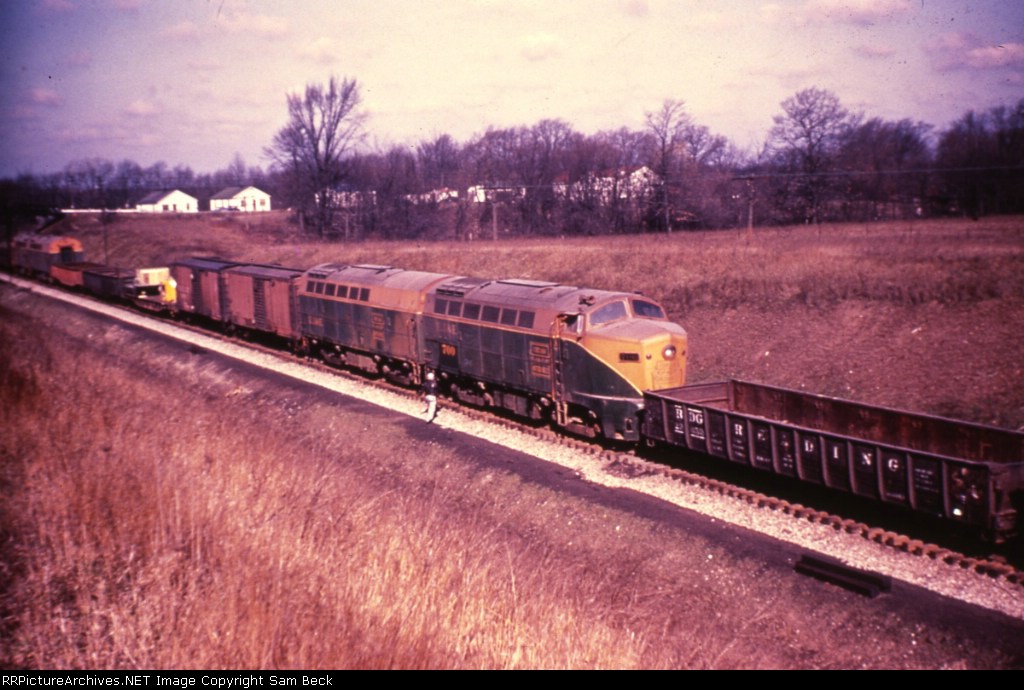
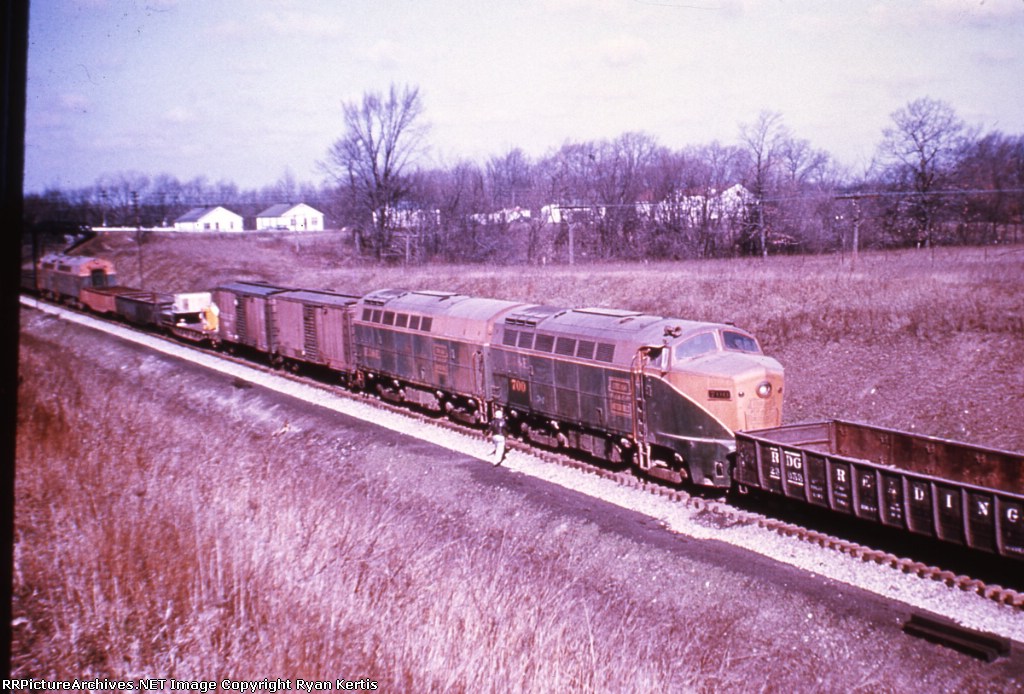
After ending up on B&O, they were renumbered and operated through 1964. They were traded in in '64 on brand-new EMD SD35s and this photo is of the #4201 at the Pielet Brothers scrapyard where it met its eventual fate.

NickD said:A better view of the Griffith crossing. Six tracks meet all in one spot, with a road through it all. The EJ&E, NYC, Grand Trunk Western (and CN, as they controlled GTW), Erie and Chesapeake & Ohio all ran through here. The Maintenance of Way guys must have hated this spot. In its heyday, 180 trains a day rolled through.
Holy berkeley that had to be a logistical nightmare!
Pete Gossett (Forum Supporter) said:NickD said:A better view of the Griffith crossing. Six tracks meet all in one spot, with a road through it all. The EJ&E, NYC, Grand Trunk Western (and CN, as they controlled GTW), Erie and Chesapeake & Ohio all ran through here. The Maintenance of Way guys must have hated this spot. In its heyday, 180 trains a day rolled through.
Holy berkeley that had to be a logistical nightmare!
On so many levels. Imagine trying to get through there on that road. No sooner would one track get clear and you'd have a train barreling down on another. Imagine being a tower operator and trying to coordinate schedules to send a train through, without computers and with no way of knowing if a train on another line was running late. Or being a track crew that had to replace one of those diamonds without snarling up traffic on 6 different railroads.
From what I can see on a modern satellite image, one set of tracks has been removed (the one heading off toward the water tower in the photo) and replaced with a trail, but the others remain.
NickD said:A better view of the Griffith crossing. Six tracks meet all in one spot, with a road through it all. The EJ&E, NYC, Grand Trunk Western (and CN, as they controlled GTW), Erie and Chesapeake & Ohio all ran through here. The Maintenance of Way guys must have hated this spot. In its heyday, 180 trains a day rolled through.
Cheebus! That's a train every 8 minutes, all day every day. Did any road traffic ever get through?
Duke said:NickD said:A better view of the Griffith crossing. Six tracks meet all in one spot, with a road through it all. The EJ&E, NYC, Grand Trunk Western (and CN, as they controlled GTW), Erie and Chesapeake & Ohio all ran through here. The Maintenance of Way guys must have hated this spot. In its heyday, 180 trains a day rolled through.
Cheebus! That's a train every 8 minutes, all day every day. Did any road traffic ever get through?
I imagine that road probably did not see that much use. If you were a railfan though, that place had to be like a shooting gallery. Just sit there for an hour and you could catch 6 or 7 trains.
In reply to NickD :
The only thing I knew about Griffith, IN was the bit from "A Christmas Story".
Did you hear about this guy who swallowed a yo-yo?
Swallowed a yo-yo?
On a bet.
Some clodhopper down in Griffith, Indiana.
They write the silliest things in the newspapers.
What do you mean, silly? I mean that's real news.
That's not like that politics slop.
Have you seen "Mighty Trains" on the Smithsonian channel? I should record all and FF through commercials, but the one last night was good; railing through the Andes.
Quite a few switchbacks going up the Devil's Nose in Ecuador. Too slow and the wheels slip and you go backwards, too fast and you're flying (with a sudden stop at the end).
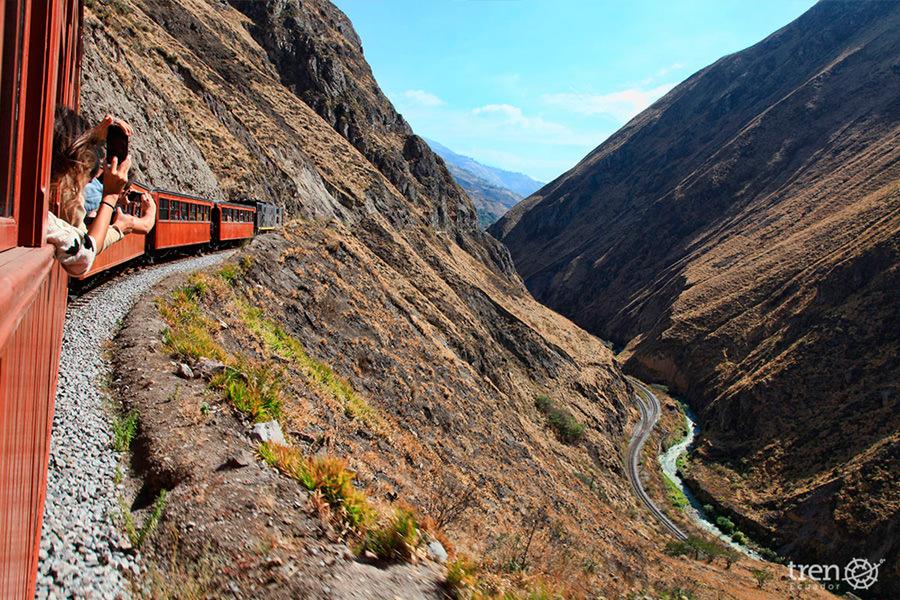
The Nevada Northern Railway is headquartered in Ely, Nevada. They own and operate several different vintage locomotives, including Steam. They host a steam photo shoot annually, and operate numerous trains throughout the year. The shops are open to visitors, and the amount of equipment there is staggering.

You'll need to log in to post.